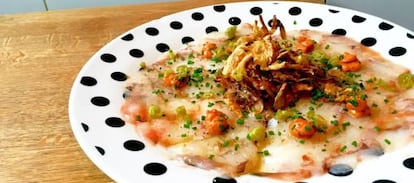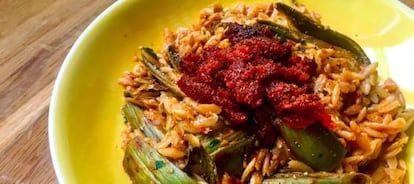Intimidated by artichokes? Follow these tips for a hassle-free preparation
Cooking this spiky vegetable can seem like a daunting task, but some methods can take as little as eight minutes, and the reward is a healthy dish packed with flavor

The artichoke is one of the undisputed queens of the winter garden. This fleshy green flower is delicate inside but can be laborious to prepare (before you read this article, of course). With a peculiar taste that is simultaneously sweet and bitter, you can decide whether you want to dedicate time to the ritual of pulling off the leaves one by one, or to scoff down their hearts in one bite. We not only have a lot of ideas on how to cook them in every possible way, but also how to select those that are at their best, tips on how to make the most of every part, and a technique that will satisfy even the laziest cooks. Long live the artichoke!
How to pick them
First you have to choose the right artichokes: go for those that are relatively heavy in comparison to their size, with well-attached, closed leaves and an intense dark green color (not tending towards brown). The leaves that are attached to the stem and the hardness of the stem can also offer a lot of information about freshness: the lusher the leaves and the harder and fleshier the stem, the better.
Raw
Eating artichokes raw is a delight that does require some work. You have to completely remove the top of the artichoke and the fibrous part of the leaves, almost right down to the heart. Remove any smaller leaves close to the stem. Then cut them into very thin slices so that they are pleasant to bite into, using a sharp paring knife or a slicer. Quickly place them in a bowl of water with lemon or parsley stalks so they do not brown.
They are delicious drained, well dried and then seasoned with olive oil, salt and pepper, but I like to add a touch of acidity with a few drops of lemon or apple cider/sherry vinegar. Let the dressing marinate for about 10 minutes so it loses some of its potency. In addition to eating them as a starter or side dish, you can also pair with anchovies, fried lardons or slices of mature cheese. They also work scattered on top of a vegetable soup, beef or cod carpaccio, or salmon tartar.
Braised

Follow the same initial instructions as above, but at the cutting stage slice the artichokes a little thicker, about two or three millimeters in width. Sauté a couple of whole cloves of garlic in olive oil, or cut the cloves in half if you want them to imbue a stronger flavor. Add the prepared artichokes and brown for a couple of minutes. Salt generously, then add three tablespoons of water and cover with a pan so they cook in the steam. Let them sizzle for two and a half minutes and repeat with more water. If after the second round they are still too hard, go for a third time.
There are many variations to this recipe. You can substitute the water for sherry or another white wine, or add chopped nuts, diced bacon or chopped mushrooms. Serve them over mashed potato or sweet potato with a boiled or fried egg, and you will be guaranteed success. You can also turn them into a warm salad if you take out the cooked garlic and crush it with oil, salt, pepper and a few drops of vinegar or lemon. They are also great with chopped hard-boiled egg and a vinaigrette with onion and bell pepper, like the one we would use for steamed leeks.
Fried
You can fry artichokes in many ways, and it all depends on how you want to serve them afterwards. It is always advisable to use plenty of olive oil, to have the heat up quite high and not to put too many in at once — this lowers the temperature of the oil and they end up going soft. To make very light chips as an appetizer or to use as a garnish on any dish, follow the same initial steps as for raw artichokes (it is very important to dry them well before they touch the oil).
If you want to bread them you can simply dip them in the flour of your choice (sift it first), and then shake them well so that they do not stick together. You are looking for a light and crunchy texture. However, the coating takes less time to burn than artichokes take to cook, so they are not very recommendable. A thicker coating like beer batter presents a problem: if you cut the artichoke thin, the dough drowns the vegetable; if you leave it big, it doesn’t cook. If you want to complicate your life, you can always steam them and then batter them to get the perfect texture.
Confit

Begin in the same way as you would to make them raw or braised, and then remove —if they have them— the fibers and leaves from the inside. The most important thing with confit is to keep the temperature of the oil low, ideally at about 70ºC (158º F) and no more than 80ºC (176ºF). To achieve this, you can use a Thermomix-style food processor, a ceramic glass hob on very low power, a gas ring set to the minimum (remove from the stove when bubbles appear) or a Roner-type low-temperature thermal circulator (with the artichokes placed in a vacuum bag with the oil). They are usually ready in about an hour or an hour and 15 minutes. It is important to let the artichokes cool in the same oil before eating seasoned with salt, on toast with labneh, or stuffed with shredded hard-boiled egg. You can also try fresh parsley and anchovies or anchovies in vinegar; the possibilities are almost endless.
Roasted
Although they need quite a bit more time, this is actually the easiest way to make them, since almost all the work is done by the oven. It works perfectly for the “leaf by leaf” method that we artichoke fans are so fond of. Start by heating the oven to 180ºC (350ºF) and cutting the stems of the artichokes just enough to keep them standing upright (set these aside for later). Without removing the outer leaves or cutting the tips, pick them up by the base and whack them on the kitchen countertop so they open up a little (without overdoing it, you don’t want to squash them).Once they are ready, transfer them onto the oven tray. If it is difficult for them to stand upright, (which sometimes happens with the smallest ones) you can use a casserole dish or container so that they are a little closer together and hold better. Season them lightly with salt, pepper and a drizzle of extra virgin olive oil. You can also toss in a spice mix.
After 45 minutes to an hour and a quarter, depending on the quantity and size of the artichokes and the power of the oven, they should be ready. You can check by pressing their bases: if they yield, they are ready. Season them a little more if you want with a few drops of vinegar or lemon, and take them to the table. The outermost leaves will be very toasted and will have protected the inner part, giving it a characteristic flavor. Don’t have an oven or are too lazy to turn it on? You can get very similar results in a shallow casserole pan with a lid.
Steamed in the microwave

To prepare them you will need... you guessed it, a microwave and some artichokes. Cut the base of between four or six artichokes, depending on their size, wash them and put them in a bowl or container that is suitable for the microwave. Add a splash of water. Cover with a plate or film and set the program for between 7 and 10 minutes at maximum power, depending on how big the artichokes are and how cooked you like them.
Once finished, take tongs or a clean kitchen towel and very carefully squeeze the base of one of the artichokes a little: if they yield to the pressure they are ready, if they are too hard, set the microwave for two more minutes. When they are ready, remove the covering and wait until you can handle them without burning yourself. Remove the outer leaves by pulling from the tips downwards: in addition to the leaves you will remove the toughest outer layer of the stem (you can also cut off the tips to leave only the hearts). Cut the artichokes in half lengthwise, starting at the base of the stem, and they are ready to eat. Don’t have a microwave? Prepare them in a pot of boiling water, in a colander or steamer, tightly covered. It will take between 35 and 45 minutes.
Stews, sauces and spreads
If you add a few chopped artichokes, a simple stew can become a standout. The only thing to bear in mind is when exactly you put them in, so they don’t turn out soft like figs or hard as a rock. Between 15 and 25 minutes is ideal, depending on the size and freshness of the vegetable. If you cannot choose the right moment because you only remembered when the stew was almost ready, you can always play with the size and cut them thinner. I like them in four or six pieces, cut lengthwise, so they are noticeable in the mix.
You can add them to any bean stew, meat stew, or with poultry, fish, shellfish, vegetables or vegetable proteins such as seitan, tofu or tempeh. They are also ideal in pasta sauces or as bases for risotto, rice dishes or stir-fries. They can even be used in sandwiches or turned into a spread by mixing them with chickpeas or beans, with a little oil and a splash of your favorite citrus juice.
Broth
Artichoke leaves can also be used to make broth. One way is to cook them in the microwave, peel them, and put the leaves in a pressure cooker for half an hour, then strain them. If you want to give the broth a little more body, you can put the leaves in a blender and then strain them. You can also add a couple of cloves of garlic, onion, the green part of a leek, pumpkin peel or other vegetable trimmings – the green stalks of carrots look great in these broths – to give it more flavor.
The stems are not considered waste but rather a delicacy. If for some reason you have had to cut them and you have them loose, you can remove the outer layer, cut them into thicker or thinner slices depending on what you are using them for and add them to vegetable soups, pasta sauces, sautés or stews. Just like pork, you can use every part (all of them delicious).
Tu suscripción se está usando en otro dispositivo
¿Quieres añadir otro usuario a tu suscripción?
Si continúas leyendo en este dispositivo, no se podrá leer en el otro.
FlechaTu suscripción se está usando en otro dispositivo y solo puedes acceder a EL PAÍS desde un dispositivo a la vez.
Si quieres compartir tu cuenta, cambia tu suscripción a la modalidad Premium, así podrás añadir otro usuario. Cada uno accederá con su propia cuenta de email, lo que os permitirá personalizar vuestra experiencia en EL PAÍS.
¿Tienes una suscripción de empresa? Accede aquí para contratar más cuentas.
En el caso de no saber quién está usando tu cuenta, te recomendamos cambiar tu contraseña aquí.
Si decides continuar compartiendo tu cuenta, este mensaje se mostrará en tu dispositivo y en el de la otra persona que está usando tu cuenta de forma indefinida, afectando a tu experiencia de lectura. Puedes consultar aquí los términos y condiciones de la suscripción digital.
More information
Últimas noticias
Rowan Atkinson tops Netflix at 70: ‘He’s as funny as ever’
Israeli recognition of Somaliland stirs up the Gulf
Tiger Woods turns 50: Will he continue playing on the PGA Tour or take a back seat?
The surreal journey of James Nnaji, the Barcelona youth player selected in the NBA Draft who ended up in the NCAA
Most viewed
- Oona Chaplin: ‘I told James Cameron that I was living in a treehouse and starting a permaculture project with a friend’
- Reinhard Genzel, Nobel laureate in physics: ‘One-minute videos will never give you the truth’
- Sinaloa Cartel war is taking its toll on Los Chapitos
- Why the price of coffee has skyrocketed: from Brazilian plantations to specialty coffee houses
- Chevy Chase, the beloved comedian who was a monster off camera: ‘Not everyone hated him, just the people who’ve worked with him’










































